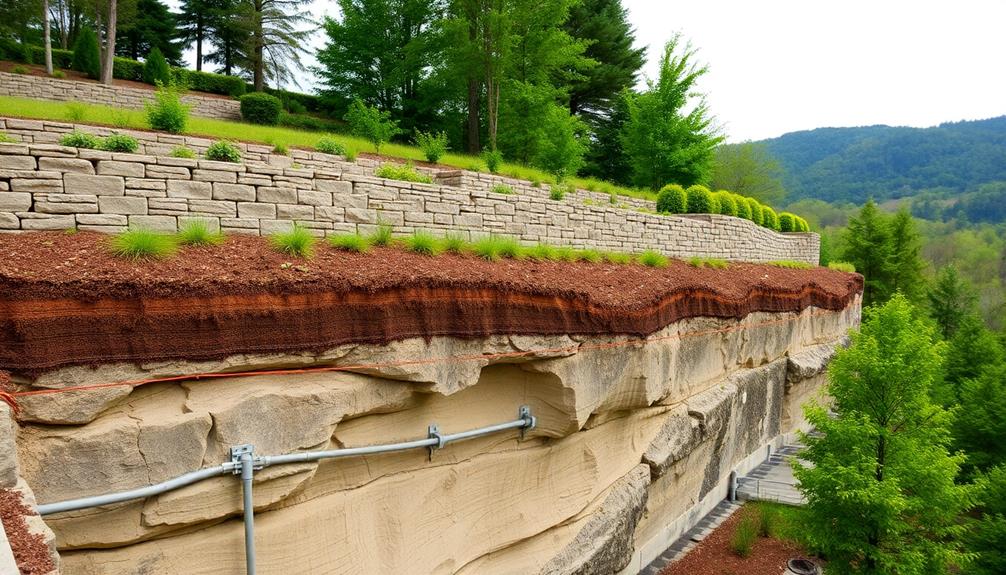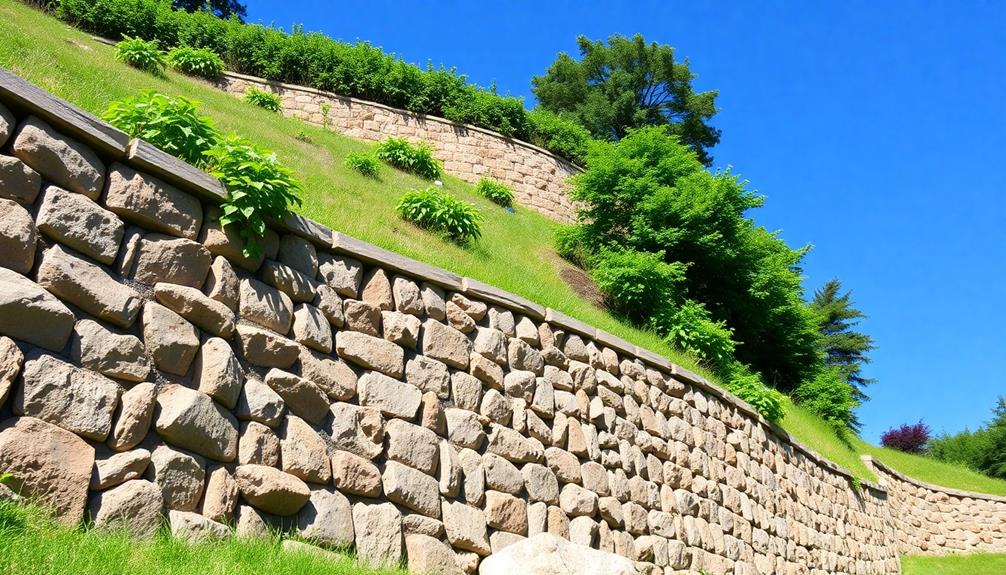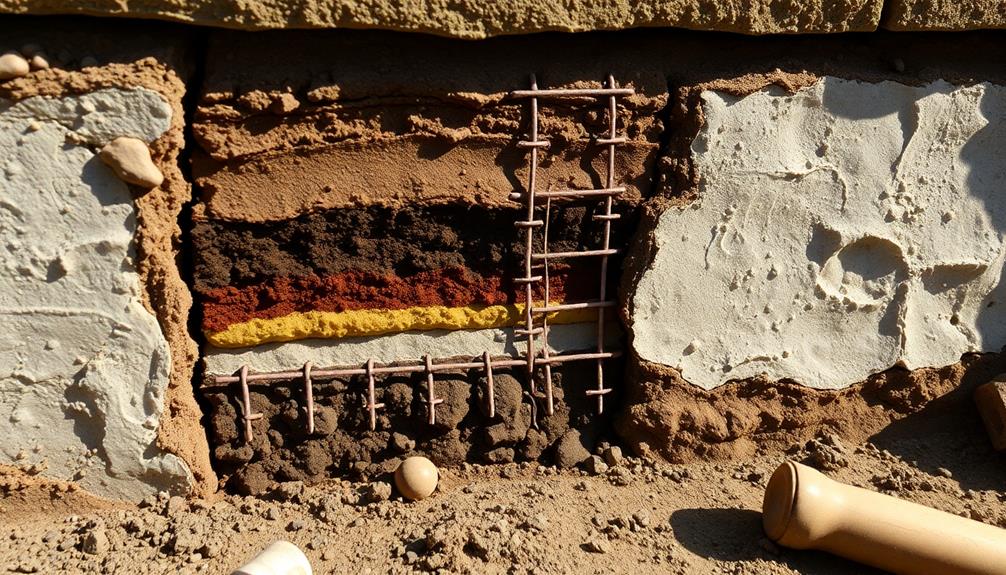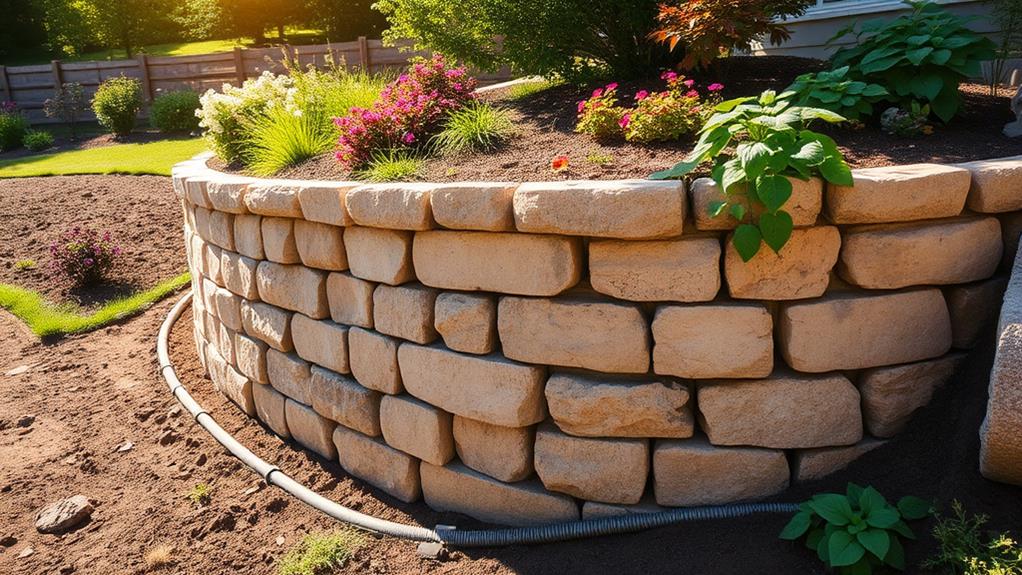Designing a retaining wall requires careful consideration of multiple factors to guarantee structural integrity, safety, and longevity. Key elements include site conditions, such as soil composition, slope angle, and groundwater presence; structural design aspects like wall height, reinforcement requirements, and drainage systems; and aesthetic considerations to integrate the wall with the surrounding landscape. Compliance with local building codes, safety standards, and budget constraints are equally pivotal. Additionally, the wall's role in erosion control, water management, and potential property value enhancement must be evaluated. The soil type and composition, particularly its organic matter content, profoundly influence the wall's specifications and necessary drainage systems. Further exploration of these factors will reveal their intricate interplay in successful retaining wall design.
Table of Contents
ToggleWalls Contractor Highlights
- Assess site conditions, including soil composition, slope angle, anticipated loads, and environmental factors like groundwater presence.
- Calculate wall height, thickness, and reinforcement requirements based on structural engineering principles.
- Consider aesthetic factors such as architectural style integration, landscaping, and material choices to enhance visual appeal.
- Ensure compliance with local building codes, safety standards, and obtain necessary permits and approvals.
- Plan for proper drainage systems and erosion control measures to manage water flow and maintain long-term stability.
Purpose of Retaining Structures

Retaining structures serve multiple critical purposes in landscaping and construction projects. These engineered systems play an essential role in preventing soil erosion, particularly on sloped terrains, by employing various stabilization techniques to hold back earth and water.
In addition to erosion control, retaining walls also function as decorative extensions of homes, enhancing the overall aesthetic appeal of the property. Additionally, retaining walls enable the creation of valuable usable space on otherwise challenging topographies, allowing for the development of level surfaces for gardens, parking areas, or building foundations in hilly or uneven environments.
Soil Erosion Prevention
Serving as a critical defense against the relentless forces of nature, retaining walls play a pivotal role in soil erosion prevention. These structures effectively mitigate the impact of water runoff, wind, and gravity on exposed soil surfaces, preserving the integrity of landscapes and protecting valuable property. By strategically intercepting and redirecting water flow, retaining walls greatly reduce the velocity and volume of runoff, thereby minimizing soil displacement and sediment transport.
The design of an effective retaining wall for erosion control incorporates several key elements. Proper drainage systems, including weep holes and backfill materials, are essential to manage hydrostatic pressure and prevent water accumulation behind the wall. Geotextile fabrics may be utilized to enhance soil stability and filtration. The wall's height, material selection, and foundation depth are carefully calculated based on site-specific factors such as soil composition, slope angle, and anticipated loads. Additionally, the incorporation of vegetation or terracing techniques can further enhance the wall's erosion prevention capabilities, creating a symbiotic relationship between the built structure and the natural environment. These design considerations guarantee that the retaining wall functions as an integral component of an all-encompassing erosion control strategy.
Slope Stabilization Techniques
Slope stabilization serves as the primary purpose of retaining structures, addressing the vital need to prevent soil movement and maintain the integrity of inclined terrain. Engineers employ various techniques to achieve this goal, each tailored to specific site conditions and project requirements.
Soil nailing, for instance, involves inserting reinforcing elements into the soil mass to increase its overall strength and stability. This method is particularly effective in areas with limited space or where excavation is challenging.
Another widely-used approach is the implementation of geosynthetic reinforcement, which incorporates high-strength materials such as geotextiles or geogrids into the soil structure. These materials work in conjunction with the soil to create a composite system capable of withstanding greater loads and resisting deformation.
For steeper slopes, mechanically stabilized earth (MSE) walls offer a robust solution, combining reinforced soil with facing elements to create a cohesive, self-supporting structure. In cases where groundwater poses a significant threat to slope stability, the installation of drainage systems becomes indispensable. These systems effectively manage water pressure within the soil, reducing the risk of slope failure and ensuring long-term structural integrity.
Creating Usable Space
Beyond slope stabilization, one of the primary purposes of retaining structures is to create usable space in areas that would otherwise be inaccessible or impractical for development. Retaining walls transform challenging terrains into valuable assets, enabling property owners to maximize their land's potential.
These structures effectively increase the usable area of a site by:
- Leveling sloped ground to create flat surfaces for landscaping, gardens, or recreational areas
- Facilitating the construction of buildings or infrastructure on previously unsuitable terrain
- Expanding outdoor living spaces by creating multi-tiered landscapes or terraces
- Providing additional parking or storage areas in urban environments with limited space
When designing retaining walls for space creation, engineers must carefully consider factors such as soil composition, drainage requirements, and load-bearing capacity. The wall's height, material selection, and reinforcement methods play indispensable roles in ensuring long-term stability and functionality. By integrating aesthetic elements into the design, retaining walls can seamlessly blend with the surrounding landscape while serving their practical purpose. Ultimately, well-designed retaining structures not only enhance property value but also contribute to the efficient utilization of land resources, benefiting both individual property owners and the broader community.
Benefits

Retaining walls offer numerous advantages that extend beyond their primary structural function. These benefits include the creation of additional usable space on sloped terrain, effective prevention of soil erosion, and a significant enhancement of overall property value.
Boulder walls are particularly excellent for stairways and large walkways, providing customizable dimensions and location options. Additionally, retaining walls can be constructed using various materials, such as limestone, which adds an elegant and natural look to any yard or home.
What's more, carefully designed retaining walls can dramatically improve landscape aesthetics, transforming challenging topography into visually appealing and functional outdoor areas.
Increased Usable Space
One of the most significant advantages of installing a retaining wall is the creation of additional usable space on a property. By effectively managing slope and soil retention, these structures transform previously unusable areas into functional landscapes. This expansion of usable terrain offers homeowners and property managers a myriad of opportunities to enhance their outdoor environments.
The increased usable space provided by retaining walls can be utilized in various ways, including:
- Expanding outdoor living areas for entertaining or relaxation
- Creating terraced gardens for improved landscaping and plant diversity
- Developing functional spaces like patios, seating areas, or outdoor kitchens
- Implementing additional parking or storage areas on sloped properties
These newly available spaces not only augment the aesthetic appeal of a property but also contribute to its overall value. By maximizing land use efficiency, retaining walls enable property owners to fully capitalize on their real estate investments. In addition, the additional usable space can foster a sense of community by providing areas for social gatherings and shared experiences among neighbors or family members, ultimately enhancing the property's functionality and desirability.
Erosion Prevention
While increased usable space is a significant advantage of retaining walls, their primary function lies in erosion prevention. These structures play a pivotal role in protecting landscapes from the destructive forces of water and wind, which can gradually wear away soil and compromise the integrity of surrounding areas. By effectively managing water runoff and soil displacement, retaining walls help maintain the stability of slopes and hillsides, preserving the natural contours of the land.
The erosion prevention capabilities of retaining walls are particularly beneficial in areas prone to heavy rainfall or steep terrain. These walls act as barriers, intercepting water flow and redirecting it away from vulnerable soil surfaces. This redirection helps to minimize soil loss and prevents the formation of gullies or other erosion-related damage. Additionally, retaining walls can be designed with built-in drainage systems, such as weep holes or perforated pipes, which further enhance their ability to manage water and reduce erosion risks. By incorporating these features, property owners can guarantee long-term protection for their landscapes, safeguarding against potential property damage and maintaining the aesthetic appeal of their outdoor spaces.
Enhanced Property Value
How does a well-designed retaining wall impact property value? A thoughtfully constructed retaining wall can dramatically enhance the overall worth of your property by improving both its aesthetic appeal and functionality. When executed properly, these structures not only serve practical purposes but also contribute to the visual harmony of your landscape, creating an inviting atmosphere that potential buyers or appraisers will appreciate.
Consider these key benefits that a well-designed retaining wall can offer to increase your property's value:
- Expanded usable space: By leveling sloped areas, retaining walls create additional flat surfaces for gardens, patios, or recreational areas.
- Improved curb appeal: Aesthetically pleasing retaining walls serve as attractive architectural elements, enhancing the overall look of your property.
- Increased structural integrity: Properly engineered walls provide long-term stability to your landscape, preventing soil erosion and potential foundation issues.
- Enhanced outdoor living potential: Retaining walls can be integrated with seating areas, fire pits, or water features, creating desirable outdoor spaces that appeal to prospective buyers.
Improved Landscape Aesthetics
Enhancing the visual appeal of your property, a well-designed retaining wall can tremendously improve landscape aesthetics. By strategically incorporating these structures into your outdoor space, you create an opportunity to transform mundane slopes into engaging focal points. Retaining walls offer a canvas for introducing diverse textures, colors, and materials that complement your existing landscaping while adding depth and dimension to the overall design.
When carefully planned, these functional elements seamlessly blend with the natural surroundings, creating a harmonious shift between different elevations. The incorporation of tiered walls can establish visually interesting terraces, perfect for showcasing ornamental plants, flowers, or even small water features.
Additionally, retaining walls provide an excellent backdrop for outdoor lighting, casting dramatic shadows and highlighting architectural details during evening hours. By selecting materials that resonate with your home's exterior and integrating complementary plantings, you can achieve a cohesive look that elevates the entire property's aesthetic appeal. This thoughtful approach to landscape design not only enhances the visual impact of your outdoor space but also creates a sense of belonging and pride for homeowners who value a well-manicured and visually striking environment.
Soil Type and Composition

When designing a retaining wall, understanding the soil type and composition is essential for ensuring stability and longevity. The characteristics of clay and sandy soils differ vastly, impacting their drainage capabilities and overall suitability for retaining wall construction. Additionally, the organic matter content in the soil influences its structural properties and potential for erosion, necessitating careful consideration during the design process.
| Soil Type | Drainage Capability | Organic Matter Content |
|---|---|---|
| Clay | Poor | Variable |
| Sandy | Excellent | Generally Low |
| Loam | Good | Moderate to High |
| Silt | Fair | Moderate |
Clay vs. Sandy Soils
Soil composition plays a critical role in retaining wall design and performance. When comparing clay and sandy soils, engineers must consider their distinct properties and behaviors. Clay soils are characterized by their fine particles and high water retention capacity, which can lead to significant expansion and contraction.
Sandy soils, conversely, are composed of larger particles and offer better drainage but less cohesion.
When designing retaining walls for these soil types, professionals must account for:
- Drainage requirements: Clay soils necessitate more robust drainage systems to prevent water accumulation and pressure buildup.
- Structural support: Sandy soils may require deeper foundations or additional reinforcement to guarantee stability.
- Frost heave potential: Clay soils are more susceptible to frost heave, necessitating deeper footings in colder climates.
- Erosion control: Sandy soils are more prone to erosion, requiring additional measures to prevent soil loss.
Understanding these soil-specific challenges allows engineers to develop tailored solutions that guarantee the longevity and effectiveness of retaining walls. By implementing appropriate design strategies, such as proper backfill selection, geotextile reinforcement, and adequate drainage systems, professionals can mitigate the inherent risks associated with each soil type and create structures that withstand the test of time.
Soil Drainage Capabilities
Building upon our understanding of clay and sandy soils, we must consider the broader spectrum of soil drainage capabilities and their impact on retaining wall design. The soil's ability to drain water efficiently is essential for the wall's long-term stability and performance. Poorly drained soils can lead to hydrostatic pressure buildup behind the wall, potentially causing structural failure or excessive movement.
To address drainage concerns, engineers must conduct thorough soil analyses to determine the soil's permeability and water retention characteristics. This information guides the selection of appropriate drainage systems, such as weep holes, perforated pipes, or granular backfill materials. In areas with high water tables or heavy precipitation, more robust drainage solutions may be necessary to prevent water accumulation behind the wall.
Additionally, the soil's drainage capacity influences the choice of construction materials and techniques. For instance, in poorly draining soils, contractors may opt for reinforced concrete or mechanically stabilized earth walls with integrated drainage features. Conversely, well-draining soils might allow for simpler gravity wall designs. By carefully considering soil drainage capabilities, designers can create retaining walls that effectively manage water flow, ensuring the structure's longevity and minimizing the risk of failure.
Organic Matter Content
Beyond soil drainage capabilities, the organic matter content plays a pivotal role in determining the suitability of soil for retaining wall construction. The presence of organic materials, such as decomposed plant matter and microorganisms, greatly influences soil structure, fertility, and stability. When designing a retaining wall, it is crucial to take into account the organic matter content of the soil, as it affects the wall's long-term performance and durability.
The organic matter content impacts retaining wall design in several ways:
- Soil compaction: Higher organic content can reduce soil density, potentially compromising the wall's structural integrity.
- Water retention: Organic-rich soils tend to retain more moisture, which can increase hydrostatic pressure behind the wall.
- Nutrient availability: Elevated organic matter levels may promote vegetation growth, affecting both aesthetics and soil stability.
- Decomposition: Over time, organic matter breakdown can lead to soil settlement, potentially causing wall movement or failure.
Conducting an exhaustive soil analysis to determine the organic matter content is essential for proper retaining wall design. This information allows engineers to make informed decisions regarding wall specifications, drainage systems, and reinforcement methods, ensuring the longevity and effectiveness of the structure in its specific soil environment.
Walls Contractor FAQ
How Often Should a Retaining Wall Be Inspected for Structural Integrity?
In our community of property owners, it's recommended to inspect retaining walls annually for structural integrity. However, after severe weather events or if you notice any changes, it's wise to conduct additional inspections to safeguard our safety.
Can Plants or Trees Be Safely Incorporated Into Retaining Wall Designs?
Plants and trees can be incorporated into retaining wall designs, but caution is necessary. Choose species with non-invasive root systems, guarantee proper drainage, and consult experts. When done correctly, vegetation can enhance both aesthetics and wall stability.
What Are the Best Materials for Building Eco-Friendly Retaining Walls?
For eco-friendly retaining walls, consider sustainable materials like reclaimed wood, recycled concrete, gabion cages filled with local stone, or living walls using native plants. These options not only reduce environmental impact but also create a sense of harmony with nature.
How Do Local Building Codes Affect Retaining Wall Construction and Design?
Local building codes greatly impact retaining wall construction and design. They typically regulate wall height, setbacks, drainage requirements, and material specifications. Compliance guarantees safety, stability, and community aesthetics. Consulting local authorities is essential for a successful project.
Are There Height Restrictions for Residential Retaining Walls in Most Areas?
Height restrictions for residential retaining walls are common in most areas. Local building codes typically set limits, often ranging from 3 to 4 feet. Higher walls may require permits, engineering plans, or special approvals from municipal authorities.







